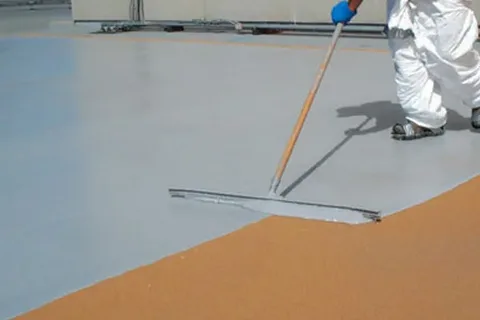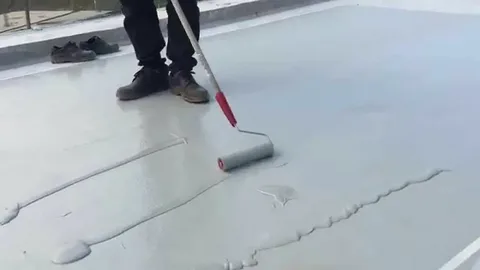Pakistan’s diverse climate, characterized by scorching summers and occasional heavy rains, poses unique challenges to the construction industry. As buildings strive to withstand these harsh conditions, the demand for effective waterproofing solutions has never been greater. In this blog, we explore the significance of cementitious waterproofing and how it is transforming the construction landscape in Pakistan.
Understanding Cementitious Waterproofing:
Cementitious waterproofing is a method that involves the application of a cement-based coating to surfaces, creating a protective barrier against water penetration. This versatile solution is well-suited for a variety of applications, including basements, roofs, and external walls, making it a popular choice for both residential and commercial construction projects.
Seamless Protection for Structures:
One of the key advantages of cementitious waterproofing is its ability to form a seamless and continuous protective layer. Unlike traditional methods that may leave joints or seams vulnerable to water infiltration, cementitious coatings provide comprehensive coverage, ensuring that every nook and cranny is shielded from the elements.

Adaptability to Various Surfaces:
Cementitious waterproofing is highly adaptable and can be applied to various surfaces, including concrete, masonry, and even existing waterproofing membranes. This flexibility makes it an excellent choice for both new construction projects and renovations, offering a reliable solution to address water-related concerns.
Durability in Challenging Conditions:
The durability of cementitious waterproofing makes it well-suited for Pakistan’s challenging climate. Resistant to UV rays, temperature fluctuations, and chemical exposure, this method provides long-lasting protection. Its effectiveness in high-stress environments makes it a go-to choice for structures facing constant weather-related challenges.
Breathability and Moisture Regulation:
Cementitious waterproofing strikes a balance between sealing out water and allowing the structure to breathe. This breathable characteristic is crucial for preventing the buildup of moisture within walls, reducing the risk of mold and mildew growth. The ability to regulate moisture levels contributes to a healthier and more sustainable building environment.

Ease of Application and Cost-Effectiveness:
The application process of cementitious waterproofing is relatively straightforward, contributing to its popularity among builders and contractors. The ease of application, coupled with its cost-effectiveness compared to some alternative methods, makes it an attractive choice for a wide range of construction projects.
Environmental Sustainability:
As the construction industry increasingly focuses on sustainable practices, cementitious waterproofing aligns with these goals. Its composition often includes environmentally friendly materials, and its longevity contributes to reducing the need for frequent repairs and replacements, minimizing overall environmental impact.
Cementitious waterproofing service stands as a stalwart defender against the challenges posed by Pakistan’s climate. As the construction industry embraces this innovative solution, structures across the country are fortified against water-related issues. From enhancing durability to promoting environmental sustainability, cementitious waterproofing is leaving an indelible mark on Pakistan’s construction landscape, ensuring that buildings stand tall and resilient in the face of nature’s forces.
Frequently Asked Questions About Cementitious Waterproofing in Pakistan
Q1: What is cementitious waterproofing, and how does it work?
A1: Cementitious waterproofing involves applying a cement-based coating to surfaces, creating a seamless barrier against water penetration. The coating adheres tightly to various surfaces, forming a protective layer that prevents water infiltration and protects structures from the damaging effects of moisture.
Q2: Where is cementitious waterproofing commonly used in Pakistan?
A2: Cementitious waterproofing is versatile and can be applied in various areas, including basements, roofs, and external walls. Its adaptability makes it a popular choice for both residential and commercial construction projects in Pakistan.

Q3: How does cementitious waterproofing provide durability in Pakistan’s climate?
A3: Cementitious waterproofing is resistant to UV rays, temperature fluctuations, and chemical exposure, making it well-suited for Pakistan’s diverse climate. Its durability ensures long-lasting protection against the harsh conditions prevalent in the country.
Q4: Can cementitious waterproofing be applied to existing waterproofing membranes?
A4: Yes, cementitious waterproofing can be applied to existing waterproofing membranes. Its versatility allows for application on various surfaces, offering an effective solution for renovations and upgrades to existing waterproofing systems.
Q5: Does cementitious waterproofing allow structures to breathe?
A5: Yes, one of the advantages of cementitious waterproofing is its ability to strike a balance between sealing out water and allowing structures to breathe. This breathable characteristic helps regulate moisture levels, reducing the risk of mold and mildew growth within walls.
Q6: Is the application process of cementitious waterproofing complex?
A6: No, the application process of cementitious waterproofing is relatively straightforward. This simplicity contributes to its popularity among builders and contractors in Pakistan. The ease of application makes it a practical choice for a wide range of construction projects.

Q7: Is cementitious waterproofing cost-effective compared to other methods?
A7: Yes, cementitious waterproofing is often considered cost-effective compared to some alternative methods. Its ease of application, durability, and versatility make it an attractive choice for builders and contractors looking for effective waterproofing solutions within budget constraints.
Q8: How does cementitious waterproofing contribute to environmental sustainability?
A8: Cementitious waterproofing can contribute to environmental sustainability. Its composition often includes environmentally friendly materials, and its durability reduces the need for frequent repairs and replacements, minimizing overall environmental impact in the long run.
Q9: Can cementitious waterproofing be used in high-stress environments?
A9: Yes, cementitious waterproofing is suitable for high-stress environments. Its durability and resistance to various environmental factors make it an excellent choice for structures facing constant challenges, ensuring effective waterproofing in demanding conditions.
Q10: Are there specific considerations for applying cementitious waterproofing in regions with heavy rainfall?
A10: In regions with heavy rainfall, proper surface preparation and attention to drainage systems are crucial when applying cementitious waterproofing. Ensuring a well-prepared substrate and efficient water runoff can enhance the effectiveness of cementitious waterproofing in areas prone to heavy rainfall.

